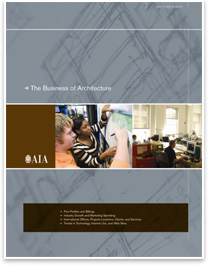
| 2005–2006 Firm Survey Shows Healthy Nonresidential Activity, Growth of Large Firms BIM and sustainability top list of growing trends Summary: The AIA is pleased to offer you—hot-off-the-press—The Business of Architecture, the 2005–2006 AIA Firm Survey, by the AIA Market Research Department, in PDF form. Through its regular surveys of architecture firms, the AIA documents trends in the changing practice of architecture and offers metrics by which firms can measure their practices and rate their performance in comparison to their peers. This document reports results from a survey conducted in 2006 and looks at the benchmarks and best practices from architecture firms.
Healthy nonresidential recovery: The survey reports that after the severe nonresidential building recession from 2000–2003, architecture firms have been enjoying a healthy recovery in design and construction activity. According to U.S. Department of Labor figures, payroll employment at architecture firms increased more than 2 percent in 2004, almost 4 percent in 2005, and is on a pace to increase close to 5 percent in 2006. As is typical for most design and construction business cycles, the upturn in design employment has surpassed the upturn in the broader economy. But recovery also presents new concerns for architecture-firm principals, many of whom have reported difficulties in recruiting qualified technical staff. Rebirth of large firms: Recovery in design and construction activity has brought with it reemerging dominance of larger architecture firms in the profession. Architecture firms with 50 or more employees accounted for less than 4 percent of all architecture firm offices but almost 42 percent of all staff at architecture firms in 2005 and almost 52 percent of all billings. More engagement in residential work: With the strong home building and remodeling markets in recent years coinciding with weak nonresidential design activity, the share of residential design activity increased to almost 18 percent of total billings in 2005, up from about 12 percent in 2002 and slightly more than 9 percent in 1999. It is likely that residential activity at firms will decline in the coming years as the residential market continues to soften, but, for the short run, architecture firms have gotten more engaged in residential design. Almost two-thirds (63 percent) of firms reported some residential projects, and close to 30 percent reported that at least one-half of their billings came from the residential sector. Sustainability and BIM increase in popularity: In terms of special trends, the new firm survey notes growth of the sustainable (green) design movement—and its related certification programs—in both residential and nonresidential projects. Another notable trend is the rise of building information modeling (BIM) or virtual design: As of 2005, about 1 in 6 architecture firms had acquired BIM software and about 1 in 10 firms was using the software on billable projects. |
||
Copyright 2007 The American Institute of Architects. All rights reserved. Home Page |
||
home
news headlines
practice
business
design
RECENT RELATED
› Nonresidential Construction Market in 2007 to Match this Year’s Strong Performance
› September’s Billings Up Modestly; Inquiries Much Stronger
Download the 2006 AIA Firm Survey Overview in PDF form.
Get the Complete Publication
Every AIA member will have the opportunity to obtain a free electronic copy of the publication. On Monday, January 8, AIA members will receive an e-mail notifying them of the publication’s availability. By replying to the message, a PDF copy of the Firm Survey will then be delivered via e-mail.

 The
The